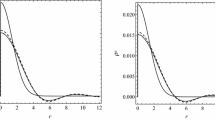Abstract
It is assumed that the singularities which occur in gravitational collapse are not visible from outside but are hidden behind an event horizon. This means that one can still predict the future outside the event horizon. A black hole on a spacelike surface is defined to be a connected component of the region of the surface bounded by the event horizon. As time increase, black holes may merge together but can never bifurcate. A black hole would be expected to settle down to a stationary state. It is shown that a stationary black hole must have topologically spherical boundary and must be axisymmetric if it is rotating. These results together with those of Israel and Carter go most of the way towards establishing the conjecture that any stationary black hole is a Kerr solution. Using this conjecture and the result that the surface area of black holes can never decrease, one can place certain limits on the amount of energy that can be extracted from black holes.
Similar content being viewed by others
References
Penrose, R.: Phys. Rev. Letters14, 57 (1965).
—— In: de Witt, C.M., Wheeler, J.A. (Eds.): Battelle Rencontres (1967). New York: Benjamin 1968.
Hawking, S.W., Ellis, G.F.R.: The large scale structure of space time. Cambridge: Cambridge University Press (to be published).
—— Penrose, R.: Proc. Roy. Soc. A314, 529 (1970).
Penrose, R.: Seminar at Cambridge University, January 1971 (unpublished).
Gibbons, G.W., Penrose, R.: To be published.
Geroch, R.P.: J. Math. Phys.11, 437 (1970).
Israel, W.: Phys. Rev.164, 1776 (1967).
Carter, B.: Phys. Rev. Letters26, 331 (1971).
—— Phys. Rev.174, 1559 (1968).
Müller zum Hagen, H.: Proc. Cambridge Phil. Soc.68, 199 (1970).
Carter, B.: Commun. math. Phys.17, 233 (1970).
Newman, E.T., Penrose, R.: J. Math. Phys.3, 566 (1962).
Hawking, S.W.: Proc. Roy. Soc. A300, 187 (1967).
Sachs, R.K.: J. Math. Phys.3, 908 (1962).
Penrose, R.: Characteristic initial data for zero rest mass including gravitation, preprint (1961).
Carter, B.: J. Math. Phys.10, 70 (1969).
Israel, W.: Commun. math. Phys.8, 245 (1968).
Lichnerowicz, A.: Théories relativistes de la gravitation et de l'électromagnétisme. Paris: Masson 1955.
Penrose, R.: Nuovo Cimento Serie 1,1, 252 (1969).
Newman, E.T., Penrose, R.: J. Math. Phys.7, 863 (1966).
Christodoulou, D.: Phys. Rev. Letters25, 1596 (1970).
Penrose, R.: Phys. Rev. Letters10, 66 (1963).
Hartle, J.B., Hawking, S.W.: Commun. math. Phys. To be published.
Hawking, S.W.: Commun. math. Phys.18, 301 (1970).
Author information
Authors and Affiliations
Rights and permissions
About this article
Cite this article
Hawking, S.W. Black holes in general relativity. Commun.Math. Phys. 25, 152–166 (1972). https://doi.org/10.1007/BF01877517
Received:
Issue Date:
DOI: https://doi.org/10.1007/BF01877517




